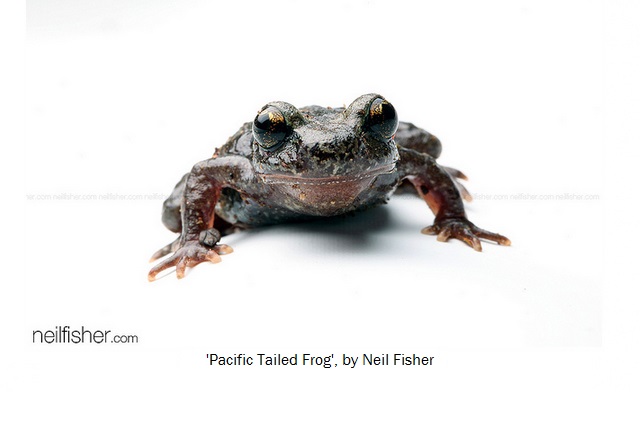This week, we chose to get a close-up on one of our favourite wetland species – the Coastal Tailed Frog (Ascaphus truei). Neil Fisher – our selected photographer – displays the complexity and delicacy of these tiny frogs in striking detail. The frog’s bulging golden-flaked eyes reflect the intricacy and their unique personality and, like Neil, we are happy to put this frog in the spotlight.
Although Neil uses a clean, soft background, these frogs are usually found in tough and wet environments. Within Canada, coastal tailed frogs only live in BC; but their range extends to California and Montana. These frogs live in flowing streams with streambeds composed of large stones or anchored boulders, which offer the frogs with shelter from the currents and algae for the tadpoles to eat. Despite streams being their habitat-of-choice, these frogs have been known to use calm pools of water and riverbanks for hunting but they must always be near water since they dry faster than other frogs.
The most recognisable feature of these frogs is, intuitively, its “tail” which is only possessed by the males and is used to internally fertilise the females. Mating occurs during the fall and the female carries the sperm until the following summer, when she lays 44-85 transparent eggs behind an underwater protective boulder. These eggs hatch roughly six weeks later and hatchlings move to calmer waters for overwintering. From there, it’ll take tadpoles roughly four years to metamorphose but these frogs can live up to 20 years – one of the longest frog lifespans in the world!
After hatchlings develop their oral suckers (which are used to scrape algae off of the streambed) they move out to areas with stronger currents, learn to cling onto rocks, and begin to eat small insects. Once these tadpoles grow older, they begin to hunt for insects, snails, and small invertebrates. Instead of using a long, sticky tongue, tailed frogs must use a “sit and wait” approach that involves pouncing on its prey and using its mouth to catch its meal.
Thank you to Neil Fisher for all of your great contributions and for including a detailed description of the coastal tailed frog’s “tails” (which can be read here). If you would like to view more of his surreal photography, please click here. Make sure to send us your wetlands photography to our Twitter (@BCWFWetlands), Facebook, and Wetlands of British Columbia Flickr group! See you in May!

Nice work from a truly nice man!
He truly is a skilled photographer!